Electric Current and Charge | Physics for Grade 12 PDF Download
Electric Current
- Electric current is defined as the rate of flow of positive charge carriers
- It is measured in units of amperes (A) or amps
- The symbol for current is I
- The charge, current and time are related by the equation:

- Where:
- I = current (A)
- ΔQ = change in charge (Q)
- Δt = time interval (s)
- When two oppositely charged conductors are connected together (by a length of wire), charge will flow between the two conductors, causing a current
 Charge can flow between two conductors. The direction of conventional current in a metal is from positive to negative
Charge can flow between two conductors. The direction of conventional current in a metal is from positive to negative
- There are several examples of electric currents, including in household wiring and electrical appliances
- Current is measured using an ammeter
- Ammeters should always be connected in series with the part of the circuit you wish to measure the current through
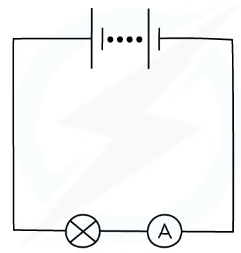 An ammeter can be used to measure the current around a circuit and always connected in series
An ammeter can be used to measure the current around a circuit and always connected in series
Example: When will 8 mA of current pass through an electrical circuit?
(a) When 1 J of energy is used by 1 C of charge
(b) When a charge of 4 C passes in 500 s
(c) When a charge of 8 C passes in 100 s
(d) When a charge of 1 C passes in 8 s
Step 1: Write out the equation relating current, charge and time, rearranging for charge Q
Q = It
Step 2: Rule out any obviously incorrect options
- Option A does not contain charge or time, so can be ruled out
Step 3: Try the rest of the options to determine the correct answer
- Consider option B:
I = 4 / 500 = 8 × 10–3 = 8 mA - Consider option C:
I = 8 / 100 = 80 × 10–3 = 80 mA - Consider option D:
I = 1 / 8 = 125 × 10–3 = 125 mA - Therefore, the correct answer is B
Electric Charge
- Charge is a property certain particles have. It can either be:
- A positive charge (+) (eg. proton)
- A negative charge (–) (eg. electron)
- A neutral (no) charge (eg. neutron)
- An atom is neutral. This is because it has an equal number of protons (positive charge) and electrons (negative) charge
- However, just the nucleus which is made up of protons and neutrons is positively charged
- In physics, the charge is represented by the symbol Q or q
The Coulomb
- The unit of charge is the Coulomb (C)
- This is defined as the quantity of charge that passes a fixed point per second when a current of 1 A is flowing
- The coulomb (C), in SI base units, is equal to the quantity of electricity conveyed in one second by a current of one ampere i.e. 1 C = 1 A s
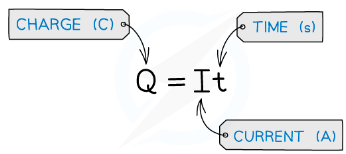 Definition of the Coulomb
Definition of the Coulomb
Quantisation of Charge
- The charge on charge carriers is quantised
- This means the charge comes in definite, finite quantities
- In this way, the quantity of charge can be quantised depending on how many protons or electrons are present
- Positive and negative charge has a definite minimum magnitude and comes in multiples of that magnitude
- This magnitude is the elementary charge, e = 1.60 × 10-19 C
- The magnitude of the charge just refers to its value, rather than whether it is positive or negative
- The net charge on a particle can be quantised, meaning it is always a multiple of the charge of an electron by convention
- The charge of an electron, e is -1.60 × 10-19 C
- The charge of a proton, +e is +1.60 × 10-19 C
Example: Determine the charge of an ion with charge 3e. State an appropriate unit for your answer.
Step 1: Calculate the charge
1e = –1.60 × 10–19
3e = 3 × (–1.60 × 10–19) = –4.8 × 10–19
Step 2: Include the unit for charge
The units of charge is coulombs (C)
Therefore 3e = –4.8 × 10–19 C
Electric Current & Electron Flow
Defining Current
- Electric current is the rate of flow of charge carriers
- This is defined as the movement of
- Electrons in metals
- Ions in electrolytes
Electrons in Metals
- In metals, such as copper, mercury and titanium, the flow of charge is made up of electrons
- The metal ions are closely packed and arranged in a crystal lattice structure
- The atoms have many free (delocalised) electrons that are free to move randomly
- These are sometimes known as conduction electrons
- These are what makes metals good conductors of electricity
- When conducting electricity, meaning one side of the metal is attaching to a negative terminal and the other to a positive, the conduction electrons drift slowly through the metal creating a current
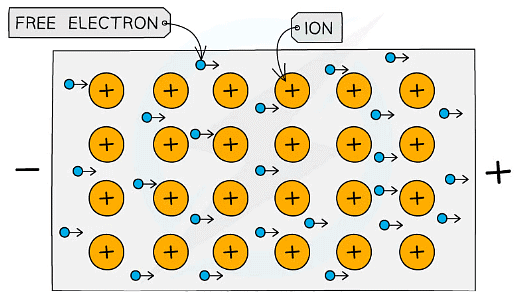 Free electrons in metal create current flow
Free electrons in metal create current flow
Ions in Electrolytes
- Ions are atoms that have lost or gained an electron. This means they are either:
- An anion - a negative ion (gained an electron)
- A cation - a positive ion (lost an electron)
- An electrolyte is a substance that produces an electrically conducting solution
- The charge carriers are not electrons, but cations and anions
- An example of an electrolyte is copper sulfate dissolved in water
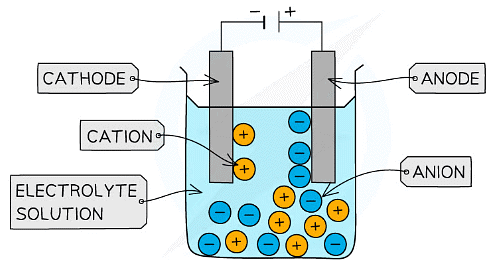 Anions are attracted to the anode and cations to the cathode
Anions are attracted to the anode and cations to the cathode
Current & Electron Flow
- In electrical wires, the current is a flow of electrons
- Electrons are negatively charged; they flow away from the negative terminal of a cell towards the positive terminal
- Conventional current is defined as the flow of positive charge from the positive terminal of a cell to the negative terminal
- This is the opposite to the direction of electron flow, as conventional current was described before electric current was really understood
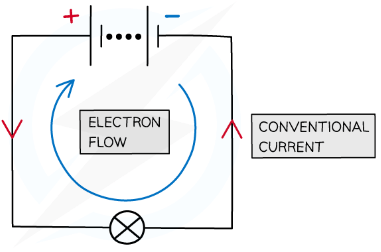 By definition, conventional current always goes from positive to negative (even through electrons go the other way)
By definition, conventional current always goes from positive to negative (even through electrons go the other way)
Kirchhoff's First Law
- Kirchhoff’s first law states that:
- The sum of the currents entering a junction always equal the sum of the currents out of the junction
- This is a consequence of conservation of charge
- Charges cannot be created nor destroyed
- Therefore, the current shouldn’t decrease or increase in a circuit when it splits
- In a circuit:
- A junction is a point where at least three circuit paths meet
- A branch is a path connecting two junctions
- If a circuit splits into two branches, then the current before the circuit splits should be equal to the current after it has split
- In the circuit below, I = I1 + I2 + I3, where I represents the current in the circuit before it branches, and I1, I2 and I3 represent the current in the respective three branches:
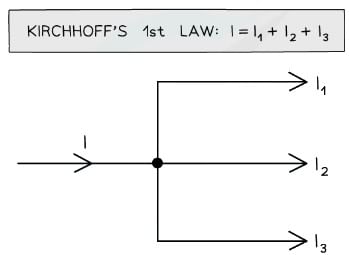 The current I into the junction is equal to the sum of the currents out of the junction
The current I into the junction is equal to the sum of the currents out of the junction
- The charge is conserved on both sides of the junction
- In a series circuit, the current is the same at any point
 The current is the same at all points in a series circuit
The current is the same at all points in a series circuit
- In a parallel circuit, the current divides at the junctions and each branch has a different value
- Kirchhoff’s first law applies at each junction
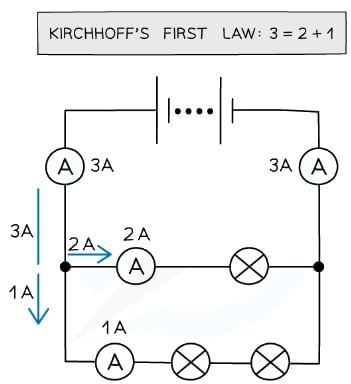 The current divides at each junction in a parallel circuit
The current divides at each junction in a parallel circuit
Current in a Current Carrying Conductor
- In a conductor, the current is due to the movement of charge carriers
- The charge carriers can be negative or positive, however, the current is always taken to be in the same direction
- In conductors, the charge carrier is usually free electrons
- However, these electrons only travel a small difference before colliding with a metal ion
- This means they have a relatively slow drift velocity, v
- In the diagram below, the current in each conductor is from right to left but the charge carriers move in opposite directions shown by the direction of the drift velocity v
- In diagram A (positive charge carriers), the drift velocity is in the same direction as the current
- In diagram B (negative charge carriers), the drift velocity is in the opposite direction to the current
 Conduction in a current-carrying conductor
Conduction in a current-carrying conductor
- The drift velocity is the average velocity of the charge carriers travelling through the conductor
- You will find this value is relatively slow (∼ 10-3 m s-1)
- However, since the number density of charge carriers is so large, the current flow still seems to happen instantaneously
Calculating Current in a Current Carrying Conductor
The current can be expressed in terms of the number density (number of charge carriers per unit volume) n, the cross-sectional area A, the drift velocity v and the charge of the charge carriers q Current in a conductor equation
Current in a conductor equation
- The same equation is used whether the charge carriers are positive or negative
- The minus sign will indicate current in the opposite direction to the charge carriers
- The charge q will be e for electrons (-1.60 × 10-19 C)
- The number density n represents the number of free charge carriers (electrons) per unit volume
- Conductors, such as metals, have a high value of n
- Insulators, such as plastics, have a small value of n
- The cross-sectional area A of a wire is the area of a circle
A = πr2 - Where:
- r = radius of the wire (m)
- This equation shows:
- v is inversely proportional to n meaning more charge carriers per unit volume will slow down their speed through the conductor
- I is directly proportional to n since greater n means greater charge is flowing and therefore a larger current I. When the value of n is lower, the charge carriers must travel faster to carry the same current
Example: A copper wire has 9.2 × 1028 free electrons m-3. The wire has a current of 3.5 A and a cross-sectional area of 1.5 mm2.Calculate the average drift speed of the electrons.
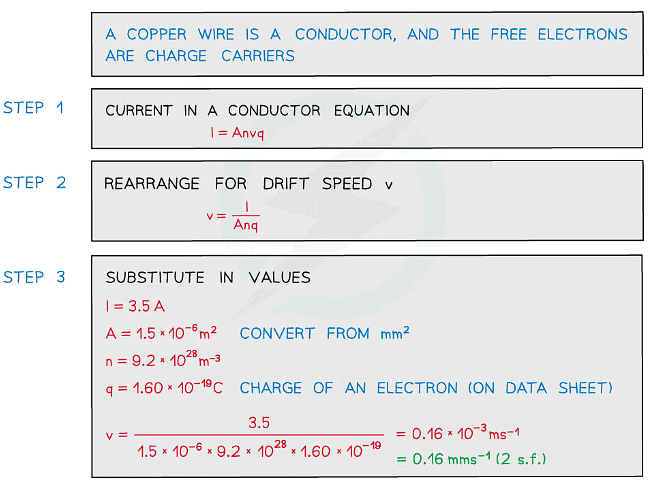
Conductors, Semiconductors & Insulators
The number density of charge carriers, n of a material determines how well the material conducts electricity
Value of n For Different Materials Table
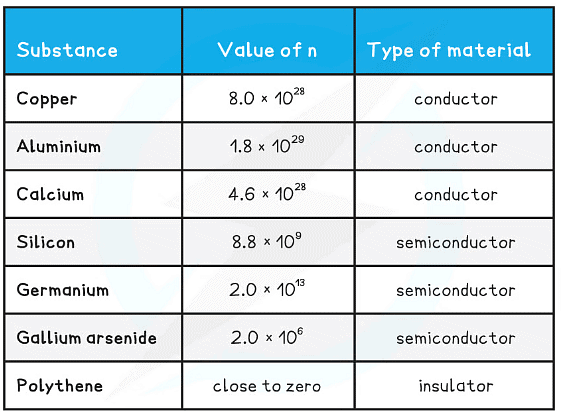
Conductors
- Conductors have a very large value of n
- This is often in the range of 1028 m-3
- This means there are many free electrons per unit volume moving through the material
- Since current is the rate of flow of electrons, this makes them very good electrical conductors
- Examples of good electrical conductors are copper, aluminium and calcium
- This is why electric wires are often made from copper and aluminium
Semiconductors
- Semiconductors are materials that have a conductivity between conductors and insulators
- Their conductivity depends on their temperature
- At low temperatures, their resistivity rises, therefore their conductivity falls
- At high temperatures, their resistivity falls, therefore their conductivity rises
- Metal conductors behave in the opposite way
- Examples of semiconductor materials are silicon and germanium
- They are often used to make electronic devices such as diodes and transistors
- Semiconductors have very intermediate conduction properties
- This means they are neither very good nor very poor in terms of their conducting properties
- Therefore, semiconductor materials undergo doping
- This is when impurities are added to the material
- This helps improve their conducting properties, by increasing the value of n
Insulators
- Insulators have a very small value of n
- This is close to 0
- This means there are next to no free electrons per unit volume moving through the material
- With no current, this makes them very poor electrical conductors
- Examples of electrical insulators include plastic, rubber and glass
- These are useful for making parts of an object in which heat or electricity should not to flow for safety reasons eg. the casing of a plug
Circuit Symbols & Diagrams
The diagrams below show the various circuit symbols that could be used in circuit diagrams
The most common symbols are:
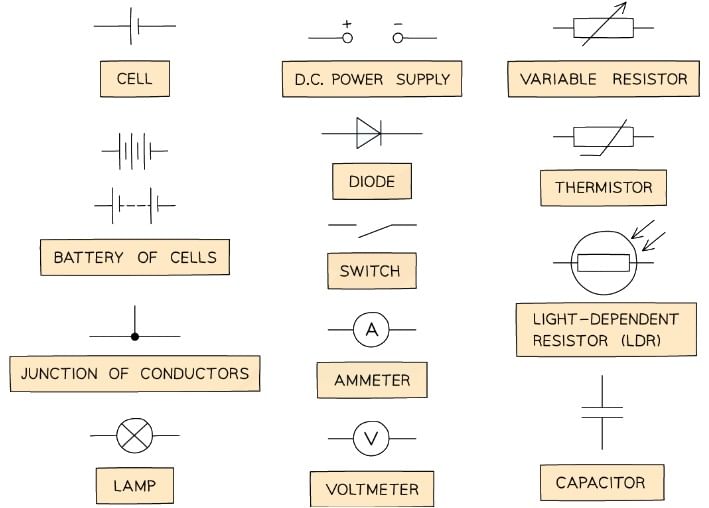
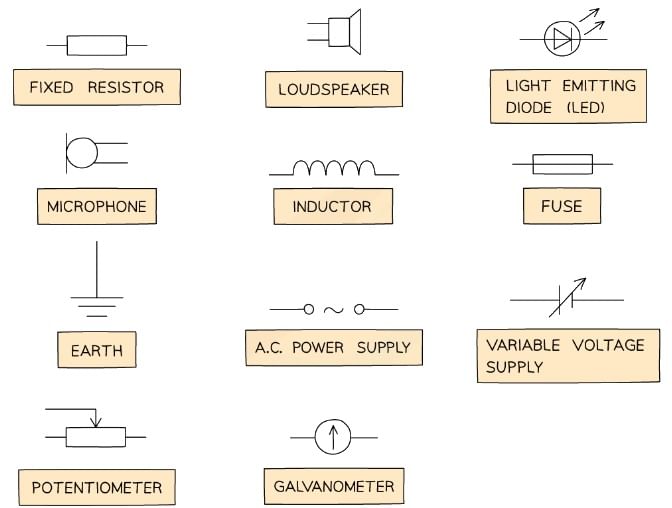
The function of the most common components are:
- Cell / battery / D.C supply: Provides the circuit with a source of e.m.f. A battery is two or more cells
- Switch: Turn the circuit on (closed), or off (open)
- Fixed resistor: A resistor limits the flow of current. A fixed resistor has a resistance it cannot change
- Variable resistor: A resistor with a slider that can be used to change its resistance. These are often used in dimmer switches and volume controls
- Thermistor: The resistance of a thermistor depends on its temperature. As its temperature increases, its resistance decreases and vice versa
- Light-dependent resistor (LDR): The resistance of an LDR depends on the light intensity. As the light intensity increases, its resistance decreases and vice versa
- Diode: A diode allows current to flow in one direction only. They are used to convert AC to DC current
- Light-emitting diode (LED): This is equivalent to a diode and emits light when a current passes through it. These are used for aviation lighting and displays (TVs, road signs)
- Ammeter: Used to measure the current in a circuit. Connected in series with other components
- Voltmeter: Use to measure the potential difference of an electrical component. Connected in parallel with the relevant component
Each of these components have an electrical resistance that may impact the current in the circuit
- However, the resistance of the ammeter and voltmeter are taken as negligible in exam questions
Circuit Diagrams
- Being able to draw and interpret circuit diagrams using circuit symbols is an essential skill in the electricity topic
- Electric circuit diagrams require the following to work effectively:
- An energy source – This is a source of e.m.f so a current can flow. This can be a cell, battery, or a power supply (D.C, A.C or variable)
- A closed path or a complete circuit – Electrons need to flow in a complete loop for a current to flow. A circuit can be open and closed using a switch
- Electrical components – These could act as sensors that respond to the environment (LDR, thermistor), or measure a value (ammeter, voltmeter), or transfer electrical energy to other forms of energy (LED, lamp). These must be drawn with the correct circuit symbol
- The key rules to remember are:
- An ammeter is always connected in series
- A voltmeter is always connected in parallel to the component the voltage is being measured
- The direction of current flow is always from the positive to the negative terminal of the power supply
Example: Which circuit diagram correctly represents a circuit with current flowing through?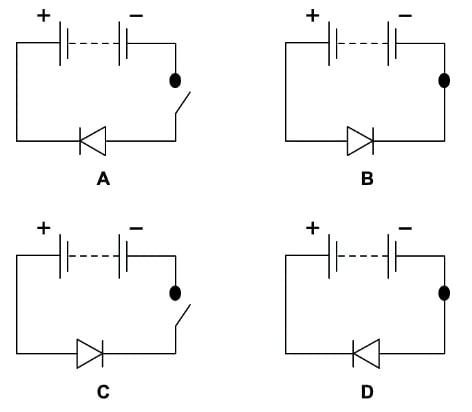
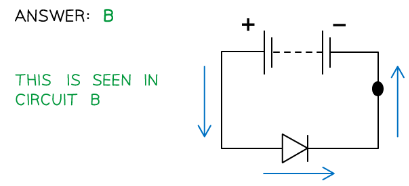
- For a circuit to be connected, the switch must be closed
- This is either circuit B or D
- The other circuit symbol is a diode
- Diodes only allow current to flow in one direction
- Since current flow is from positive to negative, a forward-biased diode must point in this direction in order for the current to flow
- This is seen in circuit B
|
161 videos|453 docs|190 tests
|















